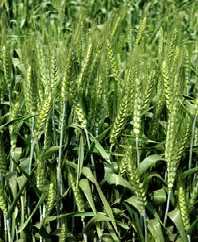Genetic blueprint of bread wheat genome unveiled, last step before full genome sequence
Indian Agricultural Scientists Make India Proud
18th July, 2014, New Delhi
Scientists from ICAR’s National Research Centre on Plant Biotechnology (NRCPB), New Delhi, Punjab Agricultural University (PAU), Ludhiana, and Delhi University South Campus (DU) in collaboration with International Wheat Genome Sequencing Consortium (IWGSC) have published a chromosome based draft sequence of the bread wheat genome in top international journal Science (18 July 2014) . This is a pride moment for the country to be part of the international effort to decode one of the world’s most important food crops. India is entrusted with the responsibility of decoding wheat chromosome ‘2A’, which alone has a genomic DNA code of about 900 million base pairs (or letters) that is about two and a half times the size of whole rice genome, and about one third of the size of the human genome. The full wheat genome is about six times the size of human genome. The Indian initiative was financially supported by the Department of Biotechnology, Ministry of Science and Technology, Government of India at a total cost of Rs 35 crores. Earlier, Indian scientists have helped crack the genetic code of rice and tomato as part of international consortia and also succeeded in decoding of pigeonpea (Arhar) and chickpea (Chana) genomes entirely on their own. |
 |
 |
Wheat was considered as one of the hardest crop plants to decode due to its huge genome size of 17000 million base pairs, and presence of three sets of highly similar chromosomes in the genome. However, technological advances made in recent years and availability of specialized genetic stocks developed during 1950s in wheat variety ‘Chinese Spring’ made it possible to isolate individual wheat chromosomes for sequencing. The chromosome-based draft sequence provides new insight into the structure, organization and evolution of the large complex genome of the world’s most widely grown cereal crop. The decoding of wheat genome has identified more than 125,000 genes assigned to the individual wheat chromosomes.
|
The draft sequence is a major landmark towards obtaining a complete reference sequence of the hexaploid bread wheat genome, the ultimate goal of the IWGSC. In the same issue of Science, another article presents the first reference sequence for the largest wheat chromosome, 3B. This establishes a proof of concept and a template for generating the reference sequence of all wheat chromosomes in the next three years. With a chromosome- based full sequence in hand, wheat breeders will have high quality tools at their disposal to accelerate breeding programs and to identify how genes control complex traits such as yield, grain quality, disease and pest resistance and tolerance to drought, heat and salt stress. They will be able to produce superior wheat varieties at an accelerated pace to meet the demands of a growing world population in a changing environment. The draft sequence is already providing new insights into the history and evolution of the wheat genome and genes involved in grain development and disease resistance. The goal of the IWGSC is to make a high quality genome sequence of bread wheat publicly available, in order to lay a foundation for basic research that will enable wheat breeders to fast track development of improved varieties.
The genetic blueprint of wheat is an invaluable resource to plant science researchers and wheat breeders. For the first time, they have at their disposal a set of tools enabling them to rapidly and precisely locate specific genes on individual wheat chromosomes. In addition, it immediately provides thousands of markers for DNA fingerprinting, diversity analysis and marker-assisted breeding in wheat. Anticipating the consequences of climate change, erratic rainfalls and global warming, ICAR has initiated major research projects on discovery of genes for tolerance to drought, heat and salt stress, resistance to devastating fungal diseases like wheat rusts, as well as bread and chapati making quality, but the progress has been slow due to non-availability of wheat genome sequence information. In the case of rice there has been a rapid progress in gene discovery and utilization during the last nine years after the publication of rice genome sequence in 2005. The availability wheat genome will now accelerate gene discovery efforts and fast track development of superior wheat varieties in a way similar to rice.
Wheat is a major dietary component of human diet across the world. Cultivated on 215 million hectares, more land than any other crop, annual world wheat production is about 700 million tons, making it the third highest produced cereal grain after maize and rice. It is the leading source of vegetable protein in human food, having higher protein content than either maize or rice.
Source and further contact:
Prof. Nagendra Kumar Singh, nksingh@nrcpb.org